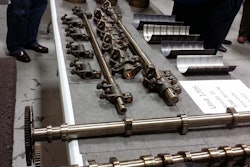The trucking industry’s transition to a new generation of engine oils, which began last December, has gone smoothly, say top engineers for Shell Rotella. All major North American engine makers are recommending use of the new lubricants, dubbed CK-4 and FA-4 oils, for their equipment, says Dan Arcy, OEM Technical Manager for Shell Rotella. The oils have also prompted all North American engine makers to extend recommended drain intervals.
What’s more, all but two heavy-duty diesel engine makers are recommending for current-model engines the use of FA-4 oils, the so-called low-viscosity oils that are intended for use in modern engines to boost fuel economy and cut emissions of greenhouse gases.
Arcy, along with Shell’s head of field testing Matt Urbanak, offered an update on the implementation of the new CK-4 and FA-4 oils in a press event held in Santa Barbara, Calif., on Sept. 20.
Paccar, maker of Paccar MX engines and owner of Peterbilt and Kenworth, is not yet recommending FA-4 oils in their current model-year engines, Arcy says. Likewise, Mack and Volvo are not recommending use of FA-4 either. However, Paccar, Volvo and Mack are all recommending use of CK-4 oils for their current model-year equipment, Arcy says.
Cummins recommends use of FA-4 oils in 2017-model X15 engines and newer. Navistar also recommends use of FA-4 oils for its new A26 engine and uses FA-4 oils as the factory fill lubricant. Detroit not only recommends use of FA-4 oils in its current-model heavy-duty engines, but for model-year 2010 and later engines.
The new generation of engine oils had been in development for five years before licensing and deployment began in December 2016. The two new oil categories replaced the former CJ-4 category, which had been in use for nearly 10 years.
Engine makers requested the new category in 2011, spurring the American Petroleum Institute, along with oil marketers, truck manufacturers and chemical companies, to develop standards and testing protocol for the new oils. Manufacturers sought the new lubricants as a means to extend drain intervals, improve fuel economy and reduce diesel engine emissions.










